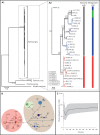Planning tiger recovery: Understanding intraspecific variation for effective conservation
- PMID: 26601191
- PMCID: PMC4640610
- DOI: 10.1126/sciadv.1400175
Planning tiger recovery: Understanding intraspecific variation for effective conservation
Abstract
Although significantly more money is spent on the conservation of tigers than on any other threatened species, today only 3200 to 3600 tigers roam the forests of Asia, occupying only 7% of their historical range. Despite the global significance of and interest in tiger conservation, global approaches to plan tiger recovery are partly impeded by the lack of a consensus on the number of tiger subspecies or management units, because a comprehensive analysis of tiger variation is lacking. We analyzed variation among all nine putative tiger subspecies, using extensive data sets of several traits [morphological (craniodental and pelage), ecological, molecular]. Our analyses revealed little variation and large overlaps in each trait among putative subspecies, and molecular data showed extremely low diversity because of a severe Late Pleistocene population decline. Our results support recognition of only two subspecies: the Sunda tiger, Panthera tigris sondaica, and the continental tiger, Panthera tigris tigris, which consists of two (northern and southern) management units. Conservation management programs, such as captive breeding, reintroduction initiatives, or trans-boundary projects, rely on a durable, consistent characterization of subspecies as taxonomic units, defined by robust multiple lines of scientific evidence rather than single traits or ad hoc descriptions of one or few specimens. Our multiple-trait data set supports a fundamental rethinking of the conventional tiger taxonomy paradigm, which will have profound implications for the management of in situ and ex situ tiger populations and boost conservation efforts by facilitating a pragmatic approach to tiger conservation management worldwide.
Keywords: Felidae; Management Units; One Plan Approach; Subspecies; Taxonomy.
Figures




Similar articles
-
Genome-Wide Evolutionary Analysis of Natural History and Adaptation in the World's Tigers.Curr Biol. 2018 Dec 3;28(23):3840-3849.e6. doi: 10.1016/j.cub.2018.09.019. Epub 2018 Oct 25. Curr Biol. 2018. PMID: 30482605
-
Phylogeography and genetic ancestry of tigers (Panthera tigris).PLoS Biol. 2004 Dec;2(12):e442. doi: 10.1371/journal.pbio.0020442. Epub 2004 Dec 7. PLoS Biol. 2004. PMID: 15583716 Free PMC article.
-
Genetic ancestry of the extinct Javan and Bali tigers.J Hered. 2015 May-Jun;106(3):247-57. doi: 10.1093/jhered/esv002. Epub 2015 Mar 8. J Hered. 2015. PMID: 25754539 Free PMC article.
-
Securing a future for wild Indochinese tigers: Transforming tiger vacuums into tiger source sites.Integr Zool. 2010 Dec;5(4):324-334. doi: 10.1111/j.1749-4877.2010.00220.x. Integr Zool. 2010. PMID: 21392350 Review.
-
Sumatran tiger (Panthera tigris sumatrae): a review of conservation status.Integr Zool. 2010 Dec;5(4):313-323. doi: 10.1111/j.1749-4877.2010.00219.x. Integr Zool. 2010. PMID: 21392349 Review.
Cited by
-
Intraspecific differentiation of Lindera obtusiloba as revealed by comparative plastomic and evolutionary analyses.Ecol Evol. 2024 Mar 11;14(3):e11119. doi: 10.1002/ece3.11119. eCollection 2024 Mar. Ecol Evol. 2024. PMID: 38469045 Free PMC article.
-
Ecological modeling, biogeography, and phenotypic analyses setting the tiger cats' hyperdimensional niches reveal a new species.Sci Rep. 2024 Jan 29;14(1):2395. doi: 10.1038/s41598-024-52379-8. Sci Rep. 2024. PMID: 38287072 Free PMC article.
-
Getting to the Meat of It: The Effects of a Captive Diet upon the Skull Morphology of the Lion and Tiger.Animals (Basel). 2023 Nov 22;13(23):3616. doi: 10.3390/ani13233616. Animals (Basel). 2023. PMID: 38066967 Free PMC article.
-
Acknowledging more biodiversity without more species.Proc Natl Acad Sci U S A. 2023 Oct 3;120(40):e2302424120. doi: 10.1073/pnas.2302424120. Epub 2023 Sep 25. Proc Natl Acad Sci U S A. 2023. PMID: 37748058 Free PMC article.
-
Ancient DNA reveals genetic admixture in China during tiger evolution.Nat Ecol Evol. 2023 Nov;7(11):1914-1929. doi: 10.1038/s41559-023-02185-8. Epub 2023 Aug 31. Nat Ecol Evol. 2023. PMID: 37652999
References
-
- Seidensticker J., Saving wild tigers: A case study in biodiversity loss and challenges to be met for recovery beyond 2010. Integr. Zool. 5, 285–299 (2010). - PubMed
-
- E. W. Sanderson, J. Forrest, C. Loucks, J. Ginsberg, E. Dinerstein, J. Seidensticker, P. Leimgruber, M. Songer, A. Heydlauff, T. O’Brien, G. Bryja, S. Klenzendorf, E. Wikramanayake, in Tigers of the World, R. Tilson, P. J. Nyhus, Eds. (Academic Press, London, ed. 2, 2010), pp. 144–161.
-
- Walston J., Robinson J. G., Bennett E. L., Breitenmoser U., da Fonseca G. A., Goodrich J., Gumal M., Hunter L., Johnson A., Karanth K. U., Leader-Williams N., Mackinnon K., Miquelle D., Pattanavibool A., Poole C., Rabinowitz A., Smith J. L. D., Stokes E. J., Stuart S. N., Vongkhamheng C., Wibisono H., Bringing the tiger back from the brink-the six percent solution. PLOS Biol. 8, e1000485 (2010). - PMC - PubMed
-
- A. C. Kitchener, N. Yamaguchi, in Tigers of the World, R. Tilson, P. J. Nyhus, Eds. (Academic Press, London, ed. 2, 2010), pp. 54–84.
-
- S.-J. Luo, W. E. Johnson, J. L. D. Smith, S. J. O’Brien, in Tigers of the World, R. Tilson, P. J. Nyhus, Eds. (Academic Press, London, ed. 2, 2010), pp. 36–51.
LinkOut - more resources
Full Text Sources
Other Literature Sources


